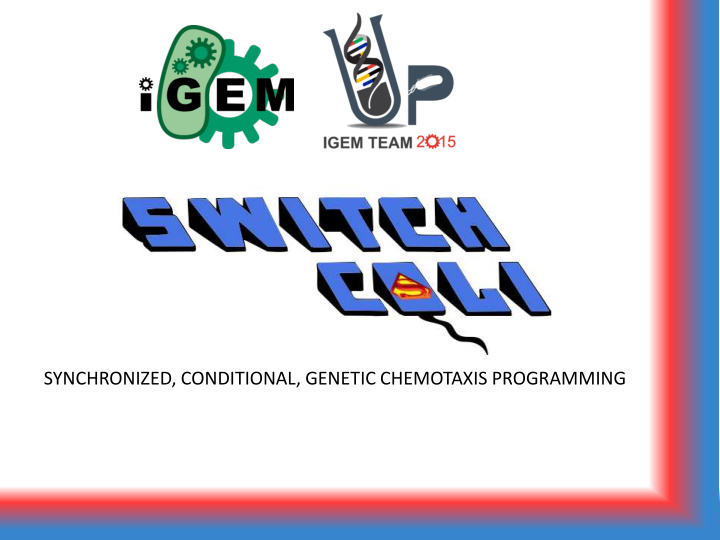



SYNCHRONIZED, CONDITIONAL, GENETIC CHEMOTAXIS PROGRAMMING
Our Story Forest Molecular Genetics research group community project
Winners of the prestigious “dot furthest from any other dot” award
Time Frame
Background Chemotactic programming – Some application • Targeted Enzymatic Delivery • Environmental Detection • WITS-CSIR_SA Bio-tweet
“Bio - tweet” http://2011.igem.org/Team:WITS-CSIR_SA Limitations to this bacterial messaging system: • Asynchronous behaviour - disparate signal • Premature reversal of motility • No communication module
Design • Quorum sensing: “Swarm” behaviour • AND Gate Logic: Combine Signals • Recombinase Gene Switch: Chemotaxis Direction • Reporter module: Relays Information about Receiver state
Design WITS-CSIR_SA
Recombinase Gene Switch Recombination using Lox71 and Lox66 produce a stable genetic change
Experimental Outline Second Phase IDT synthesis Cloning First Phase
Results Restriction digests of the constructs were cloned into pSB plasmids and amplified using the standard VF and VR primers
Results Sequence data analysis revealed deletion in ORF of Cre generator resulting in frame shift Time constraints: • Re-clone • Re-order All the other fragment had correct sequences
Future Recombinase switches characterisation from E.coli cell lines containing the different iterations of the switches and correct inducible Cre construct. • IPTG Dilution series • Fluorescent Microscopy controls – GFP and RFP BBa_I13522 BBa_I13521 pLac Induction
Human Practices S YNTHETIC B IOLOGY A WARENESS AND A TTITUDES A MONG S OUTH A FRICAN Y OUTHS : A C OMPARISON OF S OCIO - ECONOMIC I NFLUENCES
Rationale • South African turbulent history of racial segregation • Free and fair elections - 1994 • Impact of this history can still be seen as income inequality and inferior education in previously disadvantaged areas
Approach • Educational outreach for Gr. 11 learners from contrasting socio- economic areas • Survey of awareness and attitudes of synthetic biology (~100 learners per school) • Statistical analysis: Kolmogorov- Smirnov and Fisher’s Exact Tests
Differences in age distributions and family education How old are you? What is the highest qualification of your parents? A. Neither of my parents have their matric B. Matric C. Diploma D. Degree E. Postgraduate F. I don’t know/I prefer not to answer P < 0.05
Differences in age distributions and family education From which source did you first find out about synthetic biology? P < 0.05
Perception of Synthetic Biology In your opinion, synthetic biology : Do you think the public is sufficiently informed and understands advances made in synthetic biology? A. Will revolutionise medicine B. I don’t know what to expect in the future C. Will not affect me directly D. Is ethical but should be carefully regulated E. Is unethical or wrong, and should be banned F. I am afraid that it will be abused P < 0.05
Consumer Choice and Future Projections Which field do you think is the most Would you make use of synthetic important in terms of focusing future biology products? synthetic biology research? P < 0.05
Summary Improved on the Bio-tweet design by adding quorum, and gate and reporter modules as well as started characterisation of the recombinase switches forming part of the project design (7 parts added to registry) Results of our human practices survey reveal and confirms the challenges facing synthetic biology in the South African context. We’ve had a fun first experience of what it means to take part in iGEM – we’ll see you next year with an ambitious new project!
Acknowledgements Individuals Dr. Steven Hussey, Prof. Zander Myburg, Dr. Eshchar Mizrachi, Prof. Jacques Theron, Marilyn Ekoka, Marco Weinberg, Natascha Muller, Schae Ind, Julie Ind, Elodie Ekoka, Danielle Roodt, Colin Balkwill, Drew Behrens, Jonathan Botha Organisations Forest Molecular Genetics (FMG) lab, Forestry and Agricultural Biotechnology Institute (FABI), Department of Genetics at the University of Pretoria Our funding bodies: Department of Science and Technology, IDT, Sappi Ltd., Mondi Ltd.
Attributions Gert Pietersen : Project management, Experimental design and execution, data capturing, Wiki editing Nomakula Zim : Wiki Content, Technical assistance Vaughn Barendsen : T-shirts, Technical Assistance, Notebook, Data Capturing Ricu Claassens : Diagram Creation, Technical Assistance, Wiki Content, Data Capturing Axel Ind : Wiki Design and Creation, Compliance Checking, Data Capturing Modjadji Makwela : Abstract, Technical Assistance Thabang Msimango : Human Practices Management, Technical Assistance, Wiki Content Brad Querl : Banner Design, Wiki Diagrams
Recommend
More recommend